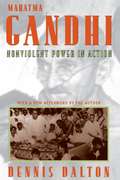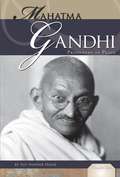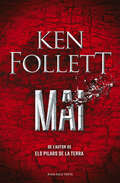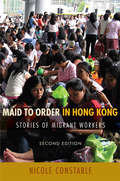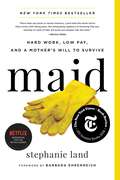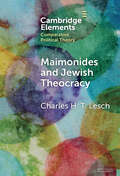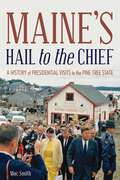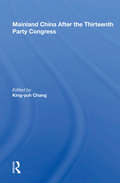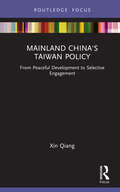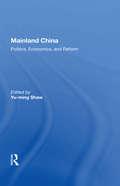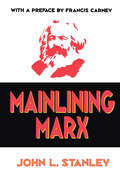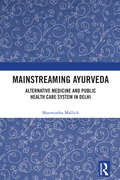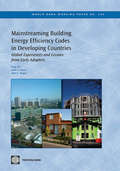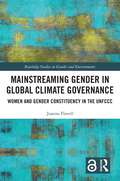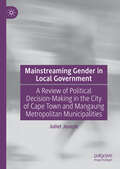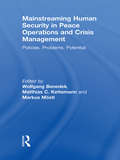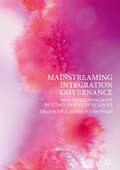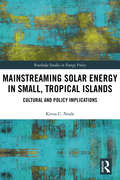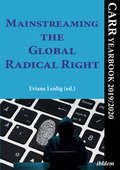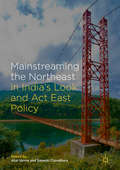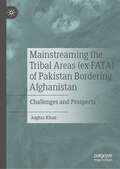- Table View
- List View
Mahatma Gandhi: Nonviolent Power in Action (Bibliographies And Indexes In World History #No. 42)
by Dennis DaltonDennis Dalton's classic account of Gandhi's political and intellectual development focuses on the leader's two signal triumphs: the civil disobedience movement (or salt satyagraha) of 1930 and the Calcutta fast of 1947. Dalton clearly demonstrates how Gandhi's lifelong career in national politics gave him the opportunity to develop and refine his ideals. He then concludes with a comparison of Gandhi's methods and the strategies of Martin Luther King Jr. and Malcolm X, drawing a fascinating juxtaposition that enriches the biography of all three figures and asserts Gandhi's relevance to the study of race and political leadership in America. Dalton situates Gandhi within the "clash of civilizations" debate, identifying the implications of his work on continuing nonviolent protests. He also extensively reviews Gandhian studies and adds a detailed chronology of events in Gandhi's life.
Mahatma Gandhi: Proponent of Peace (Essential Lives)
by Sue Vander HookEssential Lives introduces the people who have shaped the world, impacted humanity, and changed the course of history. Mahatma Gandhi is a biography of a freedom fighter of India who was leading the Freedom Movement to get rid of British Rule. His name was Mohandas Karamchand Gandhi, but people all over the world called him Mahatma--the "Great Soul." To his followers in India, he was Bapu--"Father" or "Father of the Nation."
Mai: La nova novel·la de Ken Follett, autor d'Els pilars de la Terra
by Ken FollettKen Follett torna al thriller amb una emocionant novel·la que imagina el que no es pot ni imaginar: la imminent amenaça de la Tercera Guerra Mundial. Des de l'abrusador desert del Sahara fins a l'ala Oest de la Casa Blanca i els passadissos del poder de les grans capitals del món, el mestre de la narrativa d'acció i suspens imagina un escenari de crisi global sense precedents en què un petit grup de personatges compromesos i tenaços lluita en una carrera contra rellotge. Mai és un thriller extraordinari, ple d'heroïnes i de mala gent, de falsos profetes, d'agents d'elit, de polítics desencantats i de cínics revolucionaris. Ens envia un missatge d'advertiment per al nostre temps i presenta una història intensa i trepidant que transporta els lectors fins al caire del que es pot imaginar. «Quan em vaig estar documentant per escriure La caiguda dels gegants em va sobtar veure que la Primera Guerra Mundial era una guerra que ningú no volia. Cap dels líders europeus de cap dels dos bàndols tenia voluntat que s'esdevingués. Però, d'un en un, els emperadors i els primers ministres, sense pretendre la guerra, van prendre un seguit de decisions -decisions lògiques i moderades- que ens van acostar un pas més a un dels conflictes més terribles que ha conegut el món. I aleshores em vaig preguntar: "Podria tornara a passar?"» KEN FOLLETT
Maid In China: Media, Morality, and the Cultural Politics of Boundaries (Routledge Studies in Asia's Transformations)
by Wanning SunMaid in China is the first systematic, book-length investigation of internal rural migration in post-Mao China focused on the day-to-day production and consumption of popular media. Taking the rural maid in the urban home as its point of departure, the book weaves together three years of engaged ethnographic research in Beijing and Shanghai with critical analyses of a diverse array of popular media, and follows three lines of inquiry: media and cultural production, consumption practices, and everyday politics. It unravels some of the myriad ways in which the subaltern figure of the domestic worker comes to be inscribed with the cultural politics of boundaries that entrench a host of inequalities—between rich and poor, male and female, rural and urban. Wanning Sun explores a number of paradoxes that the domestic worker lives out on a daily basis: her ubiquitous invisibility, her enduring transience, and her status as an intimate stranger. Collectively, these paradoxes afford her a unique window onto the spaces and practices of the modern Chinese city. This intimate stranger’s epistemological status makes her an unauthorized yet authoritative witness of urban residents’ social lives, offering a revealing lens through which to examine both the formation of new social relations in post-reform urban China, and the new social uses of space—both domestic and public—engendered by these relations.
Maid to Order in Hong Kong: Stories of Migrant Workers, Second Edition
by Nicole ConstableMiddle-class Chinese women in the global city of Hong Kong have entered the workforce in unprecedented numbers over the past three decades, and the demand for foreign domestic workers has soared. A decade ago some foretold the decline in foreign workers and the influx of mainland workers. But today over 120,000 women from the Philippines, over 90,000 from Indonesia, and thousands more from other parts of South and Southeast Asia serve as maids on two-year contracts in Hong Kong, sending much needed remittances to their families abroad. Nicole Constable tells their story by updating Maid to Order in Hong Kong with a focus on the major changes that have taken place since Hong Kong's reunification with mainland China in 1997, the Asian financial crisis of the late 1990s, and the outbreak of SARS in 2002-2003. Interweaving her analysis with the women's individual stories, she shows how power is expressed in the day-to-day lives of Filipina domestic workers and more-recent Indonesian arrivals.
Maid: Hard Work, Low Pay, and a Mother's Will to Survive
by Stephanie Land"A single mother's personal, unflinching look at America's class divide (Barack Obama)," this New York Times bestselling memoir is the inspiration for the Netflix limited series, hailed by Rolling Stone as "a great one." At 28, Stephanie Land's dreams of attending a university and becoming a writer quickly dissolved when a summer fling turned into an unplanned pregnancy. Before long, she found herself a single mother, scraping by as a housekeeper to make ends meet.Maid is an emotionally raw, masterful account of Stephanie's years spent in service to upper middle class America as a "nameless ghost" who quietly shared in her clients' triumphs, tragedies, and deepest secrets. Driven to carve out a better life for her family, she cleaned by day and took online classes by night, writing relentlessly as she worked toward earning a college degree. She wrote of the true stories that weren't being told: of living on food stamps and WIC coupons, of government programs that barely provided housing, of aloof government employees who shamed her for receiving what little assistance she did. Above all else, she wrote about pursuing the myth of the American Dream from the poverty line, all the while slashing through deep-rooted stigmas of the working poor.Maid is Stephanie's story, but it's not hers alone. It is an inspiring testament to the courage, determination, and ultimate strength of the human spirit."A single mother's personal, unflinching look at America's class divide, a description of the tightrope many families walk just to get by, and a reminder of the dignity of all work." -PRESIDENT BARACK OBAMA, Obama's Summer Reading List
Mailman: My Wild Ride Delivering the Mail in Appalachia and Finally Finding Home
by Stephen Starring GrantAn exuberant, hilarious, and profound memoir by a mailman in the Blue Ridge Mountains of Virginia, who found that working for the post office saved his life, taught him who he was, gave him purpose, and educated him deeply about a country he loves but had lost touch with.Steve Grant was laid off in March of 2020. He was fifty and had cancer, so he needed health insurance, fast. Which is how he found himself a rural letter carrier in Appalachia, back in his old hometown. Suddenly, he was the guy with the goods, delivering dog food and respirators and lube and heirloom tomato seeds and Lord of the Rings replica swords. He transported chicken feed to grandmothers living alone in the mountains and forded a creek with a refrigerator on his back. But while he carried the mail, he also carried a whole lot more than just the mail, including a family legacy of rage and the anxiety of having lost his identity along with his corporate job. And yet, slowly, surrounded by a ragtag but devoted band of letter carriers, working this different kind of job, Grant found himself becoming a different kind of person. He became a lifeline for lonely people, providing fleeting moments of human contact and the assurance that our government still cares. He embraced the thrill of tackling new challenges, the pride of contributing to something greater than himself, the joy of camaraderie, and the purpose found in working hard for his family and doing a small, good thing for his community. He even kindled a newfound faith. A brash and loving portrait of an all-American institution, Mailman offers a deeply felt portrait of both rural America and the dedicated (and eccentric) letter carriers who keep our lives running smoothly day to day. One hell of a raconteur, Steve Grant has written an irreverent, heartfelt, and often hilarious tribute to the simple heroism of daily service, the dignity and struggle of blue-collar work, the challenge and pleasure of coming home again after twenty-five years away, and the delight of going the extra mile for your neighbors, every day.
Maimonides and Jewish Theocracy: The Human Hand of Divine Rule (Elements in Comparative Political Theory)
by Charles H. LeschTheocratic movements are on the rise. But what does it actually mean for God to rule? This Element offers one answer by recovering the theocratic project of medieval Judaism's most important thinker, Moses Maimonides. Theocracy is often thought to quash human agency, evoking an overpowering deity and clerical domination. Yet by reconsidering Maimonides' debt to the Islamic philosopher al-Fārābī, and challenging Leo Strauss' influential reading, the author argues that among Maimonides' aims was to elevate humanity's role in divine rule. In its highest form reason is identical with revelation, action with providence. God's governance is delegated: theocracy requires human agency-the imitation of God. Maimonides focuses on philosophical-religious leaders. But he also broadens imitatio dei to anyone whose knowledge of God inspires love of God: By emulating God's goodness, we can become agents of divine rule. In this way, Maimonides' ideas suggest ways by which theocracy and democracy might, counter-intuitively, be reconciled.
Maine's Hail to the Chief: A History of Presidential Visits to the Pine Tree State
by Mac SmithA visit from the President of the United States always brings with it excitement. In Maine, perhaps part of that excitement stems from the fact that presidents rarely visit the state–only 18 of the 45 presidents have visited Maine in the nation&’s 244-year history. Many of these visits came at significant points in a presidency; and some visits had controversy, conflict, and ironic twists. For example: * During George Washington&’s visit, Maine was not even Maine, it was part of Massachusetts.* President Ulysses S. Grant was the hero of the recently ended Civil War.* President Richard Nixon was met with protests that saw Mainer battle Mainer.* President Carter spent the night of his visit with a common, ordinary Maine family, in their modest home.* President Trump&’s visit came in the middle of a global pandemic.Each of Maine's presidential visits left us with great stories, and a detailed view of Maine's lively history.
Mainland China After The Thirteenth Party Congress
by King-Yuh ChangThis book is an outcome of the conference "Communist China After the Thirteenth Party Congress" held in Taipei. It raises few questions on the relationship between ideology and politics in mainland China.
Mainland China's Taiwan Policy: From Peaceful Development to Selective Engagement (Routledge Focus on Public Governance in Asia)
by Xin QiangThe Taiwan issue has always been a core national interest of mainland China, which has steadfastly vowed to fulfill national reunification. This book provides a comprehensive and updated explanation of the strategic motivations, behavioral logic, and policymaking rationale of Beijing’s Taiwan policy. It will aid readers in predicting the future development of cross-Strait relations, reducing the risk of strategic miscalculations, and defusing potential geostrategic perils. The book analyzes Beijing’s changing policy toward Taiwan during the Kuomintang and Democratic Progressive Party administrations. It explains the key driving forces for Beijing’s Taiwan policy in these different periods, which have displayed fundamental shifts from confrontation to cooperation and then back to confrontation. The book also delves into how the rising strategic rivalry between China and the US may influence Beijing’s Taiwan policy and the prospect of cross-Strait relations in the near future. The book will be a useful reference to deepen intellectual understanding of Beijing’s broader security and diplomatic policies. It will also appeal to government policymakers who have a keen and vested interest in peace and security in the West Pacific.
Mainland China: Politics, Economics, And Reform
by Yu-ming ShawOver the past several years, Mainland China has undertaken reforms in various domestic areas, including culture and society, education, the economy, and the Communist Party. In addition, since September 1982 Peking has begun to pursue an independent course in foreign relations. In this volume, based on the Thirteenth Sino-American Conference in Tai
Mainline Mama: A Memoir
by Keeonna HarrisA powerful exploration of self-resilience, family, and community from activist and prison abolitionist Keeonna Harris.Keeonna and Jason met as young teens. Only fourteen, Keeonna had never had a boyfriend before, dreamed of attending Spelman to become an obstetrician, and thought she was “grown.” Within a year she was pregnant and Jason was in prison, convicted of a carjacking and sentenced to twenty-two years. Overnight Keeonna had become a “mainline mama,” a parent facing the task of raising a child—while still growing up herself—with an incarcerated partner. In this triumphant memoir, Keeonna recalls her challenging journey as a mainline mama, from learning to overcome the exhausting difficulties of navigating the carceral system in the United States to transforming herself into an advocate for women like her—the predominantly Black and Brown women left behind to pick up the pieces of their families and fractured lives. Keeonna speaks frankly about the forces that threatened to defeat her, how she learned to re - build her broken relationship with a mother who had lost trust in her, and how time eased the shame, guilt, and stigma of being a young Black teen mom with a partner behind bars. She offers inspiration and solace, showing how to create moments of beauty, humanity, and love—such as picking the perfect wedding dress for a ceremony in a state prison visiting room—in a place de - signed to break spirits. Mainline Mama is about creating self-love and community—crucial acts of radical resistance against a prison industrial complex designed to dehumanize and to separate and shut away incarcerated individuals and their loved ones from the world.
Mainlining Marx
by John L. StanleyIn recent years a host of Western Marxists have tried to emancipate Marx from responsibility for various unsavory doctrines. Political theorists have argued that Marx can avoid the weight of Stalinism and also the various theories, such as positivism, naturalism, Darwinism, technological determinism and the dialectics of nature that support Marxism. In the course of building up their defense of Marx, these modern critics have developed an elaborate but often confusing rationale whose premise consists of attributing many of the nefarious tendencies of Marxism to Engels, particularly the latter's philosophy of nature. In Mainlining Marx, John L. Stanley sets Marx's view of nature back in its proper perspective.Stanley challenges the "new orthodoxy" of prominent Marxist scholars who see a fundamental dichotomy between Marx and Engels with the latter believing in cosmic superlaws and the former adhering to historically grounded ones. Stanley argues both Marx and Engels used historical and transhistorical laws at various times. He is highly critical of those who abstract theoretical principles out of texts Marx wrote with specific and historical political goals in mind. He takes issue, as well, with critics who posit a Marxian belief in communist as against natural needs, and further challenges the new orthodoxy in his analysis of Marx's dissertation, showing that from the beginning Marx's thought was grounded in materialist determinism.Supplementing the chapters on Marx and his critics, the volume concludes with an essay on Georges Sorel's approach to textual analysis and interpretation, showing how Sorel, far in advance of his time realized the impossibility of completely objective analysis and the inevitable distortion of the subject under study.Throughout this volume, Stanley's critical approach utilizes Sorel's illuminating insights to point out the distortions in modern Marxian analysis. Challenging and original, Mainlining Marx is a major contribution to the study of Marxism. It will be read by economists, political scientists, and intellectual historians.
Mainstream – freie Meinung – Populismus: Interdisziplinäre Beiträge zur Debattenkultur und zu Spaltungstendenzen der Gesellschaft
by Lothar HäberleDer Mainstream, prinzipiell wandelbar, ist seit einigen Jahren geprägt von erheblicher Enge (d.h. Diskurs-Ächtung einiger Teile der Gesellschaft). Meinungsfreiheit implodiert, besonders durch Ausgrenzungen Privater. Zudem radikalisieren sich kleinere Gruppen, wozu das Internet viel beiträgt. Im Populismus – von rechts wie von links – haben gesellschaftliche Spaltungstendenzen dann schon deutliche Prägung erfahren. Die Frage, wann und ob das Phänomen einer im engeren Sinne „gespaltenen Gesellschaft“ vorliegt, wird hier kaum direkt behandelt, die acht Buchbeiträge jedoch stehen in vielfältiger Beziehung hierzu. Gesellschaftlichen Spaltungstendenzen kann entgegnet werden: u.a. durch Beachtung einiger Diskurs-Grundsätze, auch im Online-Bereich.
Mainstreaming Ayurveda: Alternative Medicine and Public Health Care System in Delhi
by Sharmistha MallickThis book brings concepts, practices of Ayurveda and its interface with modern health care set-up in Delhi, India. It presents a new conceptual framework in studying public health in India, offers policy recommendations and outlines the challenges of mainstreaming of alternative medical systems in India.Drawing on a wealth of primary data that looks at the social profile of patients, gender, disease profile of patients, prescriptions, average cost per prescription and kinds of medicines prescribed, the monograph explores patterns of health behaviour through the perceptions of doctors and patients, administrators and their negotiations with the bureaucratic health structure. It analyses the power and structures between practitioners of modern medicine and Ayurvedic doctors and the issues of cross referral and formal and informal levels of interaction/network between the two medical systems. Engaging with current debates around public health in India, the volume will be of interest to scholars and researchers of public health and sociology of health and medicine, public policy and public administration and South Asian studies.
Mainstreaming Building Energy Efficiency Codes in Developing Countries
by Anke S. Meyer Feng Liu John F. HoganUrbanization and growing wealth in developing countries portend a large increase of demand for modern energy services in residential, commercial and public-service buildings in the coming decades. Pursuing energy efficiency in buildings is vital to energy security in developing countries and is identified by the Intergovernment Panel on Climate Change as having the greatest potential for cost-effective reduction of CO2 emissions by 2030 among all energy-consuming sectors. Building energy efficiency codes (BEECs), along with energy efficiency standards for major appliances and equipment, are broadly recognized as a necessary government intervention to overcome persistent market barriers to capturing the economic potential of energy efficiency gains in the residential, commercial and public-service sectors. Implementation of BEECs help prevent costly energy wastes over the lifecycles of buildings in space heating, air conditioning, lighting, and other energy service requirements. Nonetheless, achieving the full potential of energy savings afforded by more energy-efficient buildings requires holding people who live or work in buildings accountable for the cost of energy services. Compliance enforcement has been the biggest challenge to implementing BEECs. This report summarizes the findings of an extensive literature survey of the experiences of implementing BEECs in developed countries, as well as those from case studies of China, Egypt, India, and Mexico. It also serves as a primer on the basic features and contents of BEECs and the commonly adopted compliance and enforcement approaches. This report highlights the key challenges to improving compliance enforcement in developing countries, including government commitment to energy efficiency, the effectiveness of government oversight of the construction sector, the compliance capacity of building supply chain, and financing constraints. The report notes that the process of transforming a country's building supply chain toward delivering increasingly more energy-efficient buildings takes time and requires persistent government intervention through uniformly enforced and regularly updated BEECs. The report recommends increased international support in strengthening the enforcement infrastructure for BEECs in middle-income developing countries. For low- and lower-middle-income countries, there is an urgent need to assist in improving the effectiveness of government oversight system for building construction, laying the foundation for the system to also cover BEECs.
Mainstreaming Gender in Global Climate Governance: Women and Gender Constituency in the UNFCCC (Routledge Studies in Gender and Environments)
by Joanna FlavellThis book explores the role of feminist activists in The United Nations Framework Convention on Climate Change and highlights the progress they have made in mainstreaming gender as a key issue in global climate governance. It is now commonplace for gender to be framed as a political issue in global climate politics within academic scholarship, but there is typically a lack of robust empirical analysis of existing advocacy approaches. Filling this lacuna, Joanna Flavell interrogates the political strategies of the Women and Gender Constituency (WGC) in the UNFCCC (The United Nations Framework Convention on Climate Change). Through a conceptual framework that integrates climate change with intersectional critical inquiry and political practice, Flavell analyses hundreds of historical documents, coupled with interviews and observations from two UNFCCC conferences. This research uncovers a so-far untold story about the history of the UNFCCC that foregrounds gender and feminist advocacy, highlighting the importance of the WGC in shaping dominant narratives of global climate governance through a series of rhetorical and procedural strategies. Overall, the book draws important conclusions around power in global climate governance and opens up new avenues for advancing a feminist green politics. This volume will be of great interest to students and scholars of environmental justice, climate politics and governance, environmental activism, and gender studies more broadly.
Mainstreaming Gender in Local Government: A Review of Political Decision-Making in the City of Cape Town and Mangaung Metropolitan Municipalities
by Juliet JosephThis book investigates the implementation of gender mainstreaming legislation and policies in South Africa, focusing on their impact on women’s empowerment in terms of representation, participation, and influence in municipal government. The objective is to understand why women remain underrepresented in leadership roles and decision-making at the district level of municipal governance. Emphasizing how municipal councils incorporate gender mainstreaming into their decision-making processes and the resulting impact, the author focuses on understanding the developments that advance municipal governments toward equitable governance and how decision-making has evolved. This book will be of interest to students and researchers in gender studies, African studies, postcolonial feminist theory, and politics, as well as policy-makers and government representatives.
Mainstreaming Human Security in Peace Operations and Crisis Management: Policies, Problems, Potential
by Wolfgang BenedekThe concept of human security is a new approach to security that focuses on the individual human being and provides policy alternatives to the traditional state-centred view, which considers the state to be the only and ultimate referent of security. Formally introduced into the United Nations system in 1994 the concept’s intellectual roots draw from international humanitarian law, human rights and human development, and since its introduction human security has been progressively integrated into the international security discourse. Mainstreaming Human Security: Policies, Problems, Potential paints a comprehensive picture of the relevance of the concept of human security in practice in a time of changing security paradigms and a challenging international environment. This volume looks at the practical implications of mainstreaming human security. It focuses on the potential, problems and policies of human security in peace operations and crisis management operations of the United Nations and of the European Union. Topics addressed by the contributors include mainstreaming human rights and human security in peace and crisis management in general and the role of human security in the EU’s Common Security and Defence Policy, security sector reform, restorative responses to human rights violations by peacemakers, human security in Serbia and in African peace operations as well as proposals for human security training. The contributions to the book focus equally on mainstreaming human security in the UN and in the EU context. The global issues discussed and conclusions drawn are of relevance for the future of security addressed by peace and crisis management operations all over the world.
Mainstreaming Integration Governance
by P.W.A. Scholten I. Van BreugelThis book provides a critical analysis of mainstreaming as one of the major contemporary trends in immigrant integration governance in Europe. Bringing together unique empirical material and theoretical insights on mainstreaming, it examines how, why and to what effect immigrant integration is mainstreamed. In the context of the rise and fall of multiculturalism across various European countries, this book explores how these countries are rethinking the governance of their increasingly diverse societies. It highlights the trends of a broad approach to immigrant integration priorities, 'mainstreamed' into generic policy domains which are now visible throughout Europe. With contributions not only on migration studies, but also policy studies and gender mainstreaming, this edited volume will appeal to scholars across these fields, as well as policymakers and practitioners.
Mainstreaming Solar Energy in Small, Tropical Islands: Cultural and Policy Implications (Routledge Studies in Energy Policy)
by Kiron C. NealeThis book explores how cultural considerations can improve policymaking to achieve mainstream solar energy in small, tropical islands. Focusing on Trinidad, Barbados and Oʻahu, Kiron C. Neale looks at how culture can affect and be affected by the policies that support the household adoption of two key energy technologies: solar water heating and photovoltaics. Drawing on interviews with residents and energy officials, and an examination of the institutional, socio-economic and physical factors that affect energy systems such as governance structures and energy resource availability, the author explores themes including the impact of insularity on energy transitions and behavioural and cultural change. Overall, this book rebrands policies as instruments of cultural change and puts forward recommendations applicable to all small, tropical islands. Following the islands’ transition to renewable energy, this book will be of great interest to scholars of energy policy, energy transitions, climate change, cultural studies and small states development, as well as industry professionals working on energy policy implementation.
Mainstreaming the Global Radical Right: CARR Yearbook 2019/2020
by Eviane Leidig2019 was a defining year for the radical right globally. From national and supranational elections that witnessed a surge in support for radical right parties to transnationally-inspired terrorist attacks in New Zealand, the USA, and Germany, the radical right is not just on the rise, but becoming an international mainstream phenomenon. The yearbook draws upon insightful analyses from an international network of scholars, policymakers, and practitioners who explore the processes and impact of the radical right. Beginning with reflections on the ideology and then historical perspectives of the radical right, the volume then turns to contemporary manifestations of movements and political parties as well as terrorism and the role of online spaces. It ends by examining various perspectives towards countering and challenging the radical right. This overview provides a widespread examination of the global radical right in 2019, which will be useful to scholars, students, policy makers, and the public.
Mainstreaming the Northeast in India’s Look and Act East Policy
by Atul Sarma Saswati ChoudhuryThis book provides a detailed account of the evolution of India's Look and Act East Policy, addressing the nuances of the policy and its efficacy for the Northeast Region. The Northeastern India as a region is landlocked, sharing most of its boundary with neighbouring countries of South and South East Asia. It empirically explores the progress in and prospects for trade, investment and connectivity between Northeast India and Southeast Asian countries. Further, it discusses a range of regional and sub-regional multilateral initiatives - e. g. the Bay of Bengal Initiative for Multi-Sectoral Technical and Economic Cooperation (BIMSTEC), Bangladesh-China-India-Myanmar (BCIM), and Mekong-Ganga Cooperation (MGC) - that could potentially strengthen the cooperation between Northeast India and neighboring regions in the social, cultural and economic spheres.
Mainstreaming the Tribal Areas (ex-FATA) of Pakistan Bordering Afghanistan: Challenges and Prospects
by Asghar KhanThe book addresses why the Pakistani state is facing persistent challenges in extending and consolidating its governance (authority) throughout its territories, especially in the former Federally Administered Tribal Areas (ex-FATA)? Even after the de jure merger, the question still remains valid that how Pakistani state could establish its governance in these tribal areas? Through multi-dimensional approaches and multi-pronged analysis of state-centric (top-down), society-centric (bottom-up) and state-in-society (mixed-horizontal) approaches, the book explains factors and dimensions that pose challenges to Pakistani state governance in ex-FATA. The main hypothesis is that societies, where state governance is absent, turn to informal governance and create informal institutions as a substitute for the weak central state governance thereby challenging the domination and control/authority of the state. The book presents policy recommendations for bringing these tribal areas into the mainstream governance system of Pakistan.
